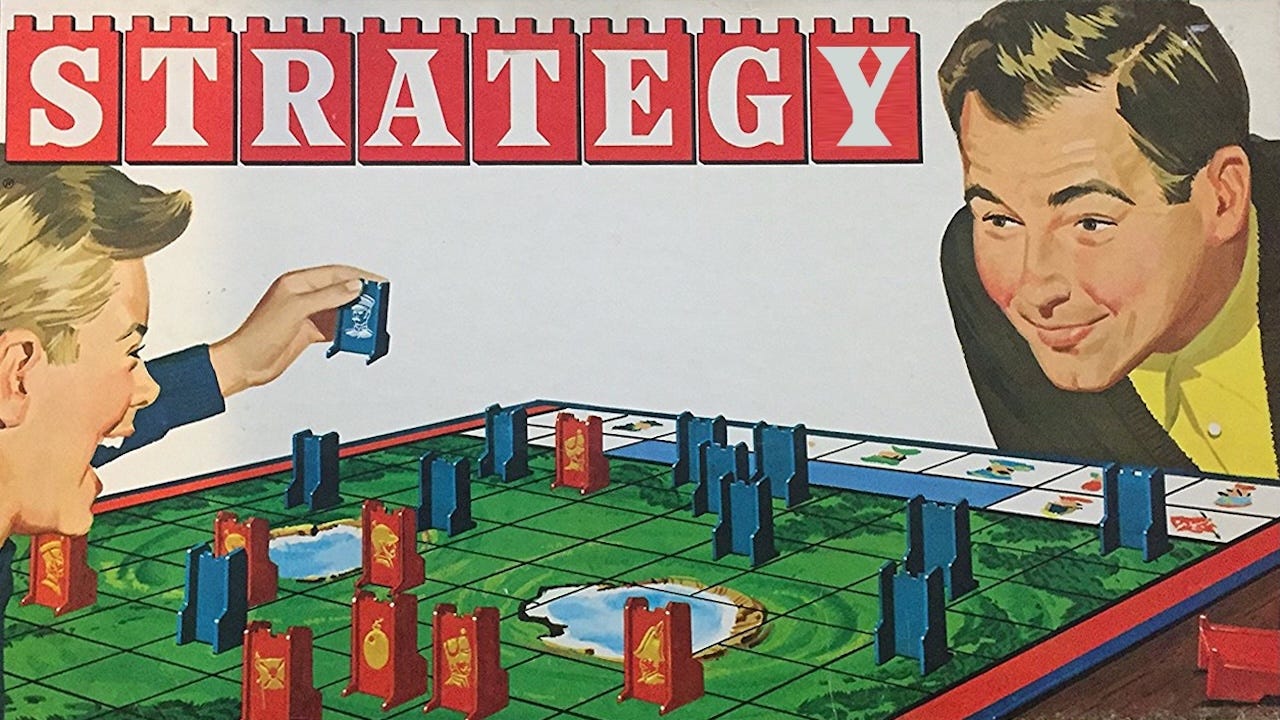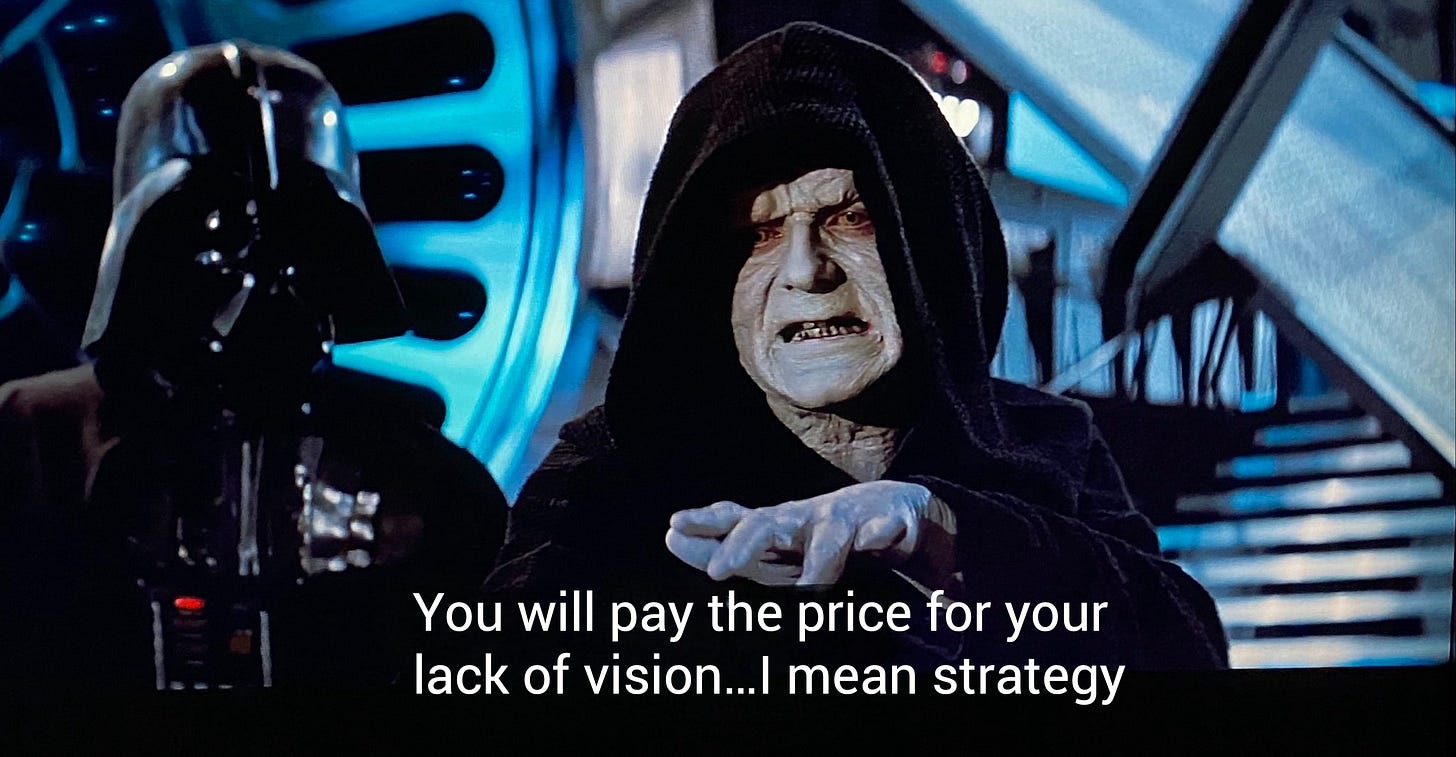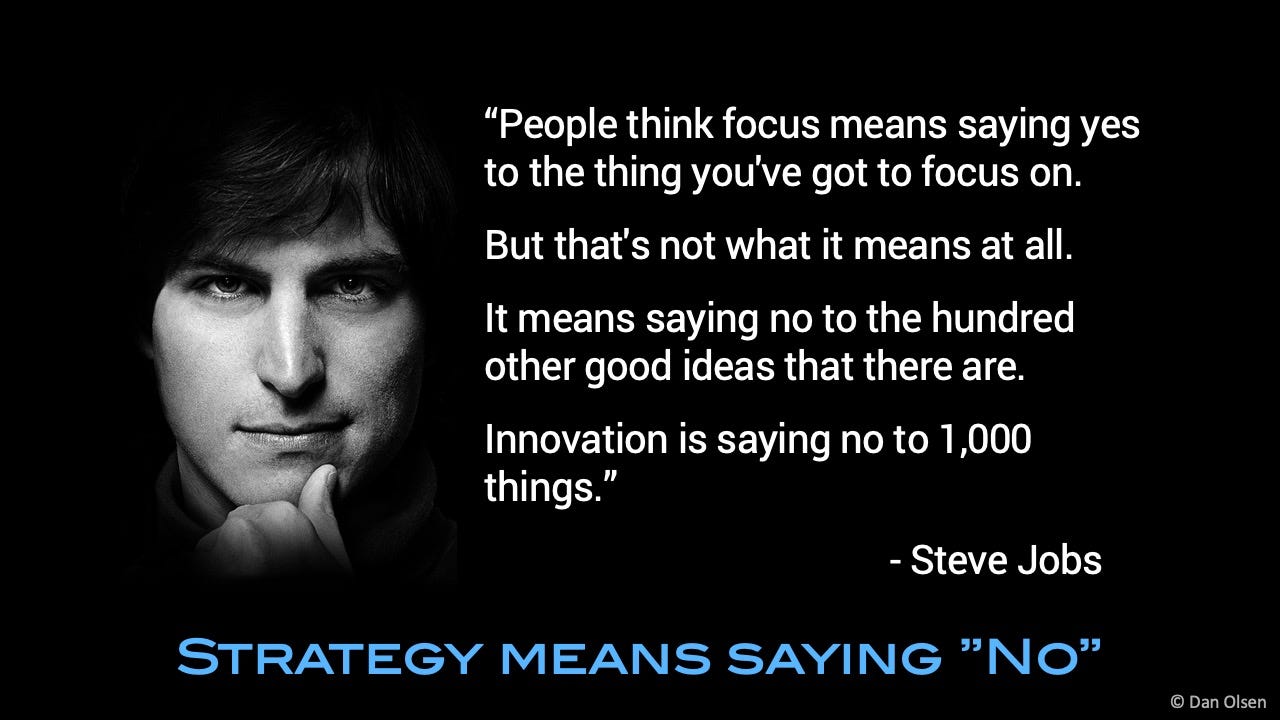What is Strategy? (and what it isn’t)
Product Strategy Series – Part 1
Strategy is one of the most overused—and misunderstood—words in business. In my experience working with many companies, only a small percentage actually have a clear, well-defined strategy.
As a product management trainer, coach, and consultant, I have helped many companies and product teams define good product strategies. This post is the first in a series of articles I plan to write about Product Strategy. Before diving into Product Strategy, I want to start by defining 'strategy' more generally.
Many people use the word strategy in various ways, but they are often not aligned on what strategy really means. In this post, I want to clarify what strategy is. When you are defining something, it can also be helpful to articulate what that thing is not, so I will be doing that in this post as well. (Borat NOT jokes anyone?)
The word strategy comes from the Greek word strategos (which means general, as in a military commander). Indeed, many dictionaries define strategy in a military context. Sun Tzu’s The Art of War is often cited in articles about strategy.
Strategy is also often discussed in the context of games. Perhaps you already know the optimal strategy for Tic Tac Toe, so that you never lose? People also talk about strategy in chess and poker, two games I enjoy playing. With many games, you can mathematically solve for the optimal playing strategy, especially with the powerful computing resources available. Any fellow Stratego fans out there? (I hacked the old school box cover of that game for this post’s hero image.)
Company Strategy
However, things are different when discussing strategy in the context of a company. For this context, I find these three definitions of strategy useful:
“A detailed plan for achieving success” (Cambridge Dictionary)
“A plan of action designed to achieve a major aim” (Oxford Languages)
“A general plan to achieve one or more long-term goals” (Wikipedia)
Analyzing these three definitions, they all share two core ideas:
Strategy involves a plan
The plan is intended to achieve an important goal or objective (e.g. success)
On the first point, it’s interesting that one definition says “detailed plan” and another says “general plan” 😀.
Only one of the three definitions mentions that the goal or objective should be “long-term,” but I think this is an important distinction between strategy and tactics (which are shorter term). I don’t think “long-term” should be thought of in absolute terms as a specific period of time. Rather, I think the definition of “long-term” can vary for a given company depending on that company’s situation.
Given the above points, I would start by defining strategy as “a plan designed to achieve long-term success.”
What Strategy Isn’t: Visions and Missions and Mottos, oh my!
Now that I’ve defined what strategy is, I want to discuss what it isn’t. There are several terms that people often conflate and confuse with strategy.
“Vision” is probably the term that is most often used as a substitute for strategy. However, for me, a vision is not as precise as a strategy. I don’t think of a vision as including any sort of plan. For me, a vision paints an aspirational picture of the future, a desired future state that the company will help create. Most definitions of vision mention “long-term” and “inspiring.” A good definition of vision is a “long-term, inspiring goal that sets the direction for a business.”
I’ve seen many people who try to create a separate vision and strategy struggle to have them be distinct but still relate to one another. Personally, I think having a clear strategy is more important than having a vision. Once you have a clear strategy, it can help inform your vision.
Somewhat related, and often just as problematic, is the term “mission.” If you search “mission” on the internet, you will see a wide range of definitions. I think the best definition of mission focuses on what the purpose of the organization is. But you can find other definitions online; frankly, there is a lot of noise out there.
If you want to have some fun, search for “vision vs. mission” or “mission vs. strategy” and try to make sense of the results you find.
I should probably also mention a company’s motto, tagline, or slogan. Many examples of a vision or mission actually reference the company’s tagline, further muddying the water. For me, a tagline or slogan is explicitly designed for “external consumption” by customers, press, etc. Taglines are carefully worded to be short, memorable, and impactful.
In contrast, a strategy is primarily designed for an internal audience. Many companies choose to keep their strategies relatively secret so that competitors don’t learn and react to them. Some companies do choose to share their strategy or parts of it publicly; some may have a public version and a separate private version.
Some examples of company missions or mottos that are often cited are:
“Don’t be evil”: Google’s motto
“Organize the world’s information”: Google’s mission
“Move fast and break things”: Facebook motto
“Don’t be evil” doesn’t describe any strategy. At best, it’s a high-level principle employees should keep in mind as they make decisions day to day. It’s arguably a high-level principle that everyone, whether they work at Google or not, should follow.
“Organize the world’s information” may sound good at first blush, but I personally think it is too high level to be actionable. Sometimes in trying to come up with a vision or strategy, people end up with something that is too high level such as “do good”, “make people happy”, etc. These are not good strategies because they are not specific enough.
“Move fast and break things” is also not a strategy or vision; it is a high-level principle that Facebook wanted employees to keep in mind as they do their work. This is an example of a desired cultural attribute.
Many companies try to document and reinforce their cultural principles and norms in “operating values,” which are yet another item that is different than strategy, vision, and mission. Intuit, where I started my product management career, has a well-defined set of operating values. They have evolved some but have served the company well for a long time (I frequently still refer to several of them).
In case you’re wondering: yes, I will be sharing examples of good product strategies in future posts.
I like to start by focusing on strategy and not worrying about vision, mission, tagline, or anything else. I’m not saying those other things aren’t valuable. I just believe strategy is the most concrete concept and the most valuable of them all. After you define your strategy, you can figure out how it relates to other things like vision, mission, etc. if you want.
Strategy Means Saying No
I want to dig deeper into defining strategy. I said strategy involves “a plan.” So what is a plan? For me, a plan is a set of decisions that a company makes. A plan is a company deciding what it intends to do in order to achieve its strategic objective. A company can pursue any number of paths. So another way to think about a plan is that it captures the specific choices the company has made from the available options.
When a company decides to pursue a certain choice or path, that usually means saying “no” to the other choices. I’ll have more to say on this in future posts, but many companies struggle with saying “no.” This is where I like to share one of my favorite Steve Jobs’ quotes about focus:
“People think focus means saying yes to the thing you’ve got to focus on.
But that’s not what it means at all.
It means saying no to the hundred other good ideas that there are.
Innovation is saying no to 1,000 things.”
–Steve JobsI like to paraphrase Steve and say “Strategy means saying No.” This is my favorite definition of strategy. If your team is not deliberately saying no to certain options or ideas, then you are not being strategic.
Strategic Decisions Have Consequences
Strategic decisions aren’t trivial; they have material consequences. By committing a company to a certain course of action, strategic decisions often preclude pursuing other options. Sometimes strategic decisions are irreversible. For example, when Spanish conquistador Hernán Cortés decided to burn all his ships after landing in Mexico, that was an irreversible strategic decision. By eliminating any other alternatives, his decision forced his troops to focus on defeating the Aztecs.
Amazon founder Jeff Bezos distinguishes two different types of decisions: one-way door and two-way door. One-way door decisions involve significant commitments and are hard to reverse. Two-way door decisions are relatively easy to reverse. Bezos uses this framework in making decisions at Amazon. He encourages two-way door decisions to be made quickly and one-way door decisions to be made only after careful analysis and consideration.
While companies can explore and experiment with possible strategies to a certain extent using two-way door decisions, I think once a company commits to a strategic choice, it is more of a one-way door decision.
Based on the above discussion, I would modify my definition of strategy to “A plan based on consequential decisions designed to achieve long-term success.”
Defining Success
Next, I want to clarify what success means. In the context of company strategy, success means winning in the marketplace. The company is in a certain market category with other competitors. The easiest way to think about this is market share: What percentage of the total market category revenue does the company capture? Market share can also be thought of as a percentage of total customers. You could also think about winning in the marketplace as having the highest profit or the largest revenue.
So what does it take for a company to “win in the marketplace?” I would argue that it requires that company to create more customer value than other alternatives. The company needs to create more customer value than its direct competitors. I use the broader term “alternative” instead of “competitors” because there may be other ways customers are getting their relevant needs met, such as more manual hacks or work arounds.
Creating superior customer value requires a differentiated product offering. Differentiation is a core component of strategy, and I’ll explore it in more depth in future posts.
Strategy Defined
Putting it all together, here is how I would define strategy:
Strategy is “a long-term plan based on consequential decisions designed to deliver higher customer value than other alternatives.”
I think this is a good definition of strategy. It captures that:
Strategy requires a long-term plan
The plan should be based on consequential decisions
The focus should be on delivering customer value
Success means being different and better than other alternatives
Update – Read the next post in my Product Strategy series: The Four Core Types of Strategy for Tech Companies.
Upcoming Posts
In my upcoming posts in this Product Strategy series, I plan to cover:
Why so few companies have a clear product strategy
A simple yet powerful framework for defining your product strategy
Examples of good and bad product strategy
I’d love to hear your thoughts about my post, so please share your comments. If you have burning questions about product strategy that you’d like me to address, please let me know.
I’m also curating a set of examples of good product strategy, so if you have an example or case study that you think is compelling, please share it with me.





Great post to kick off what is sure to be a really helpful series. I love the simplicity of the definition "Strategy is “a long-term plan based on consequential decisions designed to deliver higher customer value than other alternatives.” Given how much of strategy is based on "what we know now" and as time goes on there is regularly "new information" I think it's important to balance the "long-term"ness with the concept that this is all our best guess based on the current vantage point. Strategy must be both "long-term" and "evolving," right?
Thank you for starting this series. Currently on the struggle bus with this exact topic. Trying to influence an organization on strategy and subsequent delivery when silos are preventing the holistic, intended goal. If an org sees itself as Engineering Led, how do you influence them to do so with Product Strategy at the helm? Is that even possible?